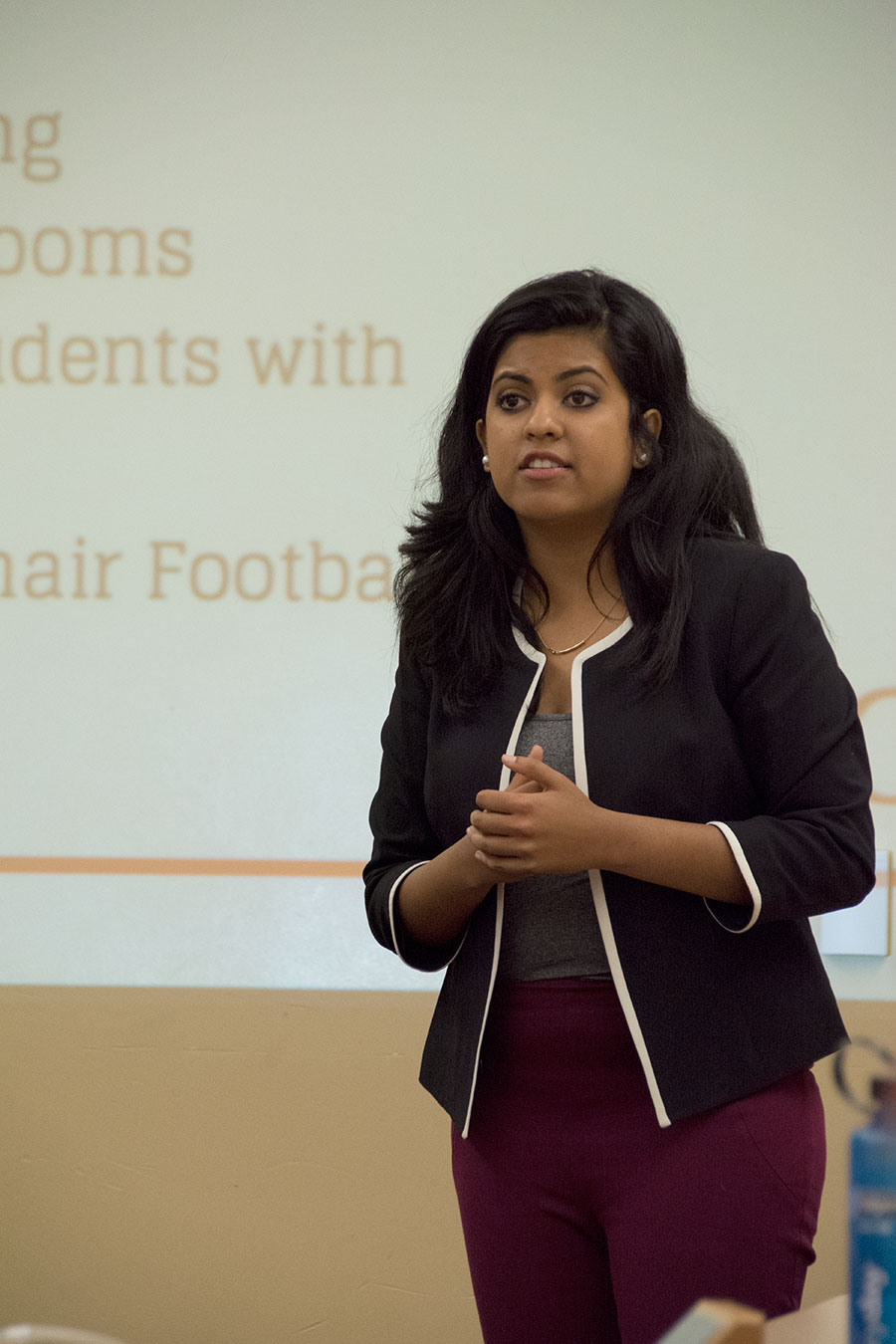USG resolution aims to promote success for black students
On Tuesday night, members of the Black Student Assembly, Diversity Affairs and the Undergraduate Student Government Senate presented the “Space for Students of Color” resolution, which aims to create a house or programming space that promotes well-being and success among black students at USC.

Our place · Undergraduate Student Government Vice President Rini Sampath speaks at the USG meeting Tuesday in Ronald Tutor Campus Center. USG’s resolution would create programming and space for black students. – Ralf Cheung | Daily Trojan
Ama Amoafo-Yeboah, executive director of Program Board, expressed the need for a university-recognized, student-run cultural center for students of color on campus.
“When you’re sitting in class all day and you’re the only black person, it’s important to feel as though you have a space to go back to … where people have had the same experience as you’ve had,” Amafo-Yeboah said.
In a survey of 116 students conducted by USG, 36 percent of black USC students ranked “available social space” as the least satisfying component of their USC experience. “Sense of belonging” was second lowest. Studies suggest a direct correlation between these factors and students’ academic retention rates.
Other universities, including Northwestern, Georgetown, and Stanford University already have social houses for black students. According to the resolution, the planned space would feature 24/7 programming capability and printing, as well as other resources that would contribute to “the success of all students on campus.”
“Having this space won’t negatively affect anyone, it’ll only be a positive for those who currently feel uncomfortable,” Amafo-Yeboah said.
Proponents hope that a house for students of color will make them more academically successful and spark a larger conversation about inequality on campus. While presenting the resolution, Amafo-Yeboah read a statement by a USC student.
“Since I am a student of color, I am not welcomed with open arms into the university,” the anonymous student said in the statement.
Skylar Dunn, co-director of Diversity Affairs, echoed this sentiment. Dunn, who co-authored the resolution, became involved with the project at the request of Amafo-Yeboah.
“I really wanted to make a specific change before I graduate,” Dunn said.
Dunn said he frequently encounters negative assumptions about black students at USC. Among them: that black students are “athletes,” or otherwise different from the rest of the student body.
“It’s one thing to tell people, ‘I go to the University of Southern California,’ and its another thing to feel like you’re a part of it,” Dunn said.
USG Vice President Rini Sampath decided to co-author the project after conversations with students of color on campus opened her eyes to the issue.
“I always knew there were issues on campus, but I never realized the degree to which it impacted students on an individual basis,” Sampath said.
Sampath pointed out that the lack of a social space for black students is at odds with the university’s mission to welcome students of “every race, creed and background.”
Levi Powell, co-director of Diversity Affairs, agreed with Sampath, saying the resolution affects every member of the student body.
“We don’t want this issue to be a reflection of people in this room, but more so a reflection of all of the minds at USC,” Powell said.
The university has approved similar initiatives in the past, such as Somerville Place, an African American-themed dorm on the fifth floor of Fluor Tower. The dorm hosted meetings for African-American clubs on campus until increased security measures made the building inaccessible to non-residents. Powell called the measures “understandable,” but stressed the current lack of social space for black students on campus.
“We’re not even talking about a space that’s ours 24/7, only a space that we can use for a few hours a week. And we don’t even have that,” Powell said.
Authors of the resolution hope that “Space for Students of Color” will have a strong educational component. BSA Executive Director Casey Ellis emphasized the importance of “the home” in African-American culture and its correlation with general success.
“Having our history on the wall as something we can show to prospective and current students is so important to our culture,” Ellis said.
Amafo-Yeboah agreed, and said the house is open to all students who want to learn about black history.
“It’s important to acknowledge the African diaspora, and educate other students who come into the space,” Amafo-Yeboah said.
The authors of the resolution have met with USC professors and administrators to discuss the project. Notable alumni such as Dr. Michelle G. Turner, MBA, Ed.D, executive director of the Black Alumni Association, were also consulted about the project.
Though proponents still have to raise funds for the space, they believe the right support will allow them to move the dialogue forward.
“The money and space are small concerns compared to the support of the administration and student body,” Sampath said.
Though they face many obstacles, proponents of the “Space for Students of Color” resolution believe that they are up to the challenge of solving them.
“This is a stepping stone … It’s about opening up a conversation,” Sampath said.

